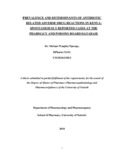| dc.contributor.author | Njoroge, Miriam W | |
| dc.date.accessioned | 2019-01-29T12:50:56Z | |
| dc.date.available | 2019-01-29T12:50:56Z | |
| dc.date.issued | 2018 | |
| dc.identifier.uri | http://hdl.handle.net/11295/105890 | |
| dc.description.abstract | Introduction: Antibiotics are used for treatment and prophylaxis of various infectious
conditions and are considered as safe drugs when used rationally. Like all other drugs, they
also cause adverse drug reactions in various patient conditions and many studies reveal that
the incidence of adverse drug reactions could be higher in case of antibiotics. Adverse drug
reactions contribute significantly to morbidity and mortality globally. The impact of adverse
reactions include their effect on patient adherence to treatment, treatment outcomes and the
development of antimicrobial resistance. Some of the documented reactions due to antibiotics
include gastrointestinal reactions, skin reactions and liver injury among others.
In Kenya, the Pharmacy and Poisons Board (PPB) is mandated to carry out
pharmacovigilance activities in the country. The national pharmacovigilance system was
established in 2004. In 2010, Kenya became a member of the World Health Organization -
Program for International Drug Monitoring (PIDM). Individual case safety reports are
submitted by healthcare workers to the PPB voluntarily to alert the regulatory body of
suspected adverse drug reactions.
Objective: The main aim of this study was to describe the prevalence and characteristics
including the type, severity and outcome of adverse drug reactions (ADRs) due to antibiotics
from the spontaneous reporting database in Kenya from January 2010 to December 2015.
Methodology: A retrospective cross sectional study was carried out at the Pharmacy and
Poisons Board. Spontaneously reported individual case safety reports (ICSRs) submitted
between January 2010 and December 2015 to the national database were reviewed. Universal
sampling was used. A pre-designed data collection form adopted from the Suspected Adverse
Drug Reaction Reporting Form was used to collect data. Information on the patients’ biodata,
diagnosis, description of the ADR, details of the suspected drug, concomitant medicines used,
severity of the reaction, outcome of the reaction and causality assessment was abstracted
from the ICSRs. Data was obtained from both manually filed and computerized reports. Data
analysis was conducted using Stata version 13.
Results: A total of 550 ICSRs were analyzed. There were more females (60.0%) with ADRs
due to antibiotics compared to males (36.6%). The median age of the cases was 34 [IQR
22.0-45.0] years. The most affected organ systems was the integumentary system (60.9%)
with skin rash (39.7%) as the most commonly reported ADR. The antibiotic classes reported
to have caused the most ADRs were sulphonamides (34.69%) followed by anti-tuberculosis
agents (16.2%). Cotrimoxazole was suspected to cause the majority (56%) of the ADRs. The
severity assessment revealed that most of the reported ADRs were moderate (50.7%) and
mild (31.9%) with 83.2% of the suspected drug being withdrawn. Complete recovery was
reported in 28.5% of the cases while 42.5% were in the process of recovering at the time of
reporting the ADR. Age was reported to be associated with the severity of the reported ADRs
while HIV status and the severity of the reported ADR were associated with an increased risk
of having an undesirable outcome or no recovery. Causality assessment was done which
showed that 66.2% of the reactions were probable, and 18.3% were certain to have been
caused by the suspected antibiotic.
Conclusion: This study showed the high burden of antibiotic related morbidity and mortality
in adults taking antibiotics. Due to the nature of the reported ADRs, majority of the cases
required an intervention to manage them. Antibiotics were also suspected to have contributed
to fatalities during the six year period (2010-2015). This study found that most of the reported
ADRs affected the skin. Majority of the ADRs occurred in HIV positive patients taking
cotrimoxazole as a prophylaxis for opportunistic infections. The HIV status of the patients
and severity of the ADRs put the patients at risk of having undesirable outcomes, including
no recovery. The findings emphasize the importance of monitoring all patients on antibiotics
especially HIV positive patients as well as children and the elderly who experienced more
severe ADRs. | en_US |
| dc.language.iso | en | en_US |
| dc.publisher | University of Nairobi | en_US |
| dc.rights | Attribution-NonCommercial-NoDerivs 3.0 United States | * |
| dc.rights.uri | http://creativecommons.org/licenses/by-nc-nd/3.0/us/ | * |
| dc.title | Prevalence and Determinants of Antibiotic Related Adverse Drug Reactions in Kenya: Spontaneously Reported Cases at the Pharmacy and Poisons Board Database | en_US |
| dc.type | Thesis | en_US |
| dc.description.department | a
Department of Psychiatry, University of Nairobi, ; bDepartment of Mental Health, School of Medicine,
Moi University, Eldoret, Kenya | |



